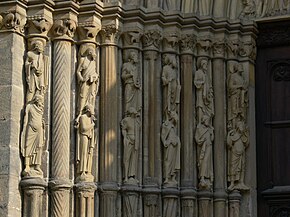Robes

The cladding or the incline is the lateral boundary of a portal , a window or an embrasure cut diagonally into the masonry , in contrast to the vertical cut reveal .
description
A rectangular door and window framing consists of the lateral posts , said overhead lintel and the underlying door threshold or the sill of the window. If, instead of the horizontal lintel, the upper end of a vestment is formed by an arch , this is called an archivolt .
The inner surfaces of the facade cut-outs are called soffits if they form right-angled (instead of inclined) cut surfaces with the wall plane. Contrasting or three-dimensional frames or cladding of windows, doors and other openings that are parallel to the wall plane are called fins .
The walls are often made of ashlar and stand out from the less evenly processed natural stones or the plastered surface of the masonry . The bevel emphasizes the wall opening and improves the incidence of light.
If the cladding is profiled, stonemasons speak of the profile trim. The thick-walled natural stone masonry Romanesque and Gothic buildings are often staggered and profiled several times one behind the other and are occupied with half-columns or columns .
history
The first garment figures firmly connected to the load-bearing structure, therefore called column statues, were created before 1140 for the early Gothic west facade of the former abbey church of Saint-Denis ( Seine-Saint-Denis ). They were lost in the 18th century. Similar garment figures can be found in the west portals (1145/55) of Chartres Cathedral . From the 13th century onwards, the drapery, especially of church portals, was increasingly emphasized, while the column statues developed into independent round figures standing freely in front of the drapery.
National peculiarity
Even if the figurative decorations are always attached to the front of the visitor, the portal frames of Indian temples , which are often designed in depth and figurative, are also sometimes referred to as 'garments'.
gallery
Column and figure-less stepped garments of the church of St-Laurent-du-Mont near Argelès-sur-Mer (mid-12th century)
Portal walls of the Church of St-Gilles in Argenton-les-Vallées (end of the 12th century)
Garment figures (13th century) on the Saint Firminus portal of the Cathedral of Amiens (north portal of the west facade)
late Romanesque giant gate of St. Stephen's Cathedral in Vienna (13th century)
The cloaks of an arrow slit inside Windsor Castle
Portal vestments at Parvati Temple in Nachna , India (5th / 6th century)
Individual evidence
- ^ Wilfried Koch : Architectural Style. European architecture from antiquity to the present. Special edition. Orbis-Verlag, Munich 1988, ISBN 3-572-05927-5 .
- ↑ Small dictionary of architecture, Reclam, p. 54
- ↑ Technical terms in architecture , p. 72
- ↑ Johannes Jahn , Wolfgang Haubenreißer: Dictionary of Art (= Kröner's pocket edition . Volume 165). 10th, revised and expanded edition. Kröner, Stuttgart 1983, ISBN 3-520-16510-4 , p. 270.
- ^ Georges Duby , Jean-Luc Duval: La Sculpture. De l'antiquité au moyen age. You VIIIe siècle avant J.-C. au XVe siècle. Deuxième partie: Le grand art du moyen-age, du Ve au XVe siècle. Bénédikt Taschen Verlag, Cologne et al. 1999, ISBN 3-8228-7102-8 , p. 350.





